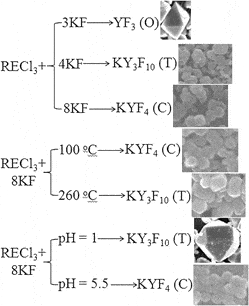Crossref Citations
This article has been cited by the following publications. This list is generated based on data provided by
Crossref.
Cao, Chunyan
Cao, Renping
Guo, Siling
Xie, An.
Noh, Hyeon Mi.
and
Jeong, Jung Hyun
2015.
Synthesis, phase evolution and optical properties of Tb3+‐doped KF–YbF3 system materials.
Luminescence,
Vol. 30,
Issue. 5,
p.
637.
XIE, An
LIU, Xiaolei
and
XIONG, Yucheng
2015.
Eu3+ doped K-Lu-F system optical materials: controlling synthesis, phase evolution, and optical properties.
Journal of Rare Earths,
Vol. 33,
Issue. 12,
p.
1261.
Cao, Chunyan
Xie, An
Noh, Hyeon Mi
and
Jeong, Jung Hyun
2016.
Solid state solutions of Ce–Tb–F and K–Ce–Tb–F: Synthesis, optical properties and energy transfer.
Journal of Fluorine Chemistry,
Vol. 183,
Issue. ,
p.
69.
Ichikawa, Rodrigo U.
Linhares, Horacio M. S. M. D.
Peral, Inma
Baldochi, Sonia L.
Ranieri, Izilda M.
Turrillas, Xavier
and
Martinez, Luis G.
2017.
Insights into the Local Structure of Tb-Doped KY3F10 Nanoparticles from Synchrotron X-ray Diffraction.
ACS Omega,
Vol. 2,
Issue. 8,
p.
5128.
Serna-Gallén, Pablo
Beltrán-Mir, Héctor
and
Cordoncillo, Eloísa
2021.
Unraveling the superior role of dicarboxylic acids as surface chelators in Eu3+-doped yttrium fluorides: A systematic modulation of the crystal phases and morphologies for highly tuned optical performance.
Journal of Alloys and Compounds,
Vol. 883,
Issue. ,
p.
160847.
Serna-Gallén, Pablo
Beltrán-Mir, Héctor
and
Cordoncillo, Eloísa
2021.
The unexplored δ-phase of KY3F10: toward novel Eu3+-doped nanoplates with a ‘super-diamond’ structure for optical applications.
Journal of Materials Research and Technology,
Vol. 15,
Issue. ,
p.
6940.
Serna-Gallén, Pablo
Beltrán-Mir, Héctor
and
Cordoncillo, Eloísa
2021.
Tuning the optical and photoluminescence properties of high efficient Eu3+-doped KY3F10phosphors by different synthetic approaches.
Optics & Laser Technology,
Vol. 136,
Issue. ,
p.
106734.
Serna-Gallén, Pablo
Beltrán-Mir, Héctor
and
Cordoncillo, Eloísa
2022.
The pH-dependent reactions in the sonochemical synthesis of luminescent fluorides: The quest for the formation of KY3F10 crystal phases.
Ultrasonics Sonochemistry,
Vol. 87,
Issue. ,
p.
106059.
LI Rongqing, 李荣青
ZHOU Weiwei, 周薇薇
TONG Yue, 童悦
ZHENG Qinghua, 郑庆华
LV Zhaocheng, 吕兆承
ZHAO Wang, 赵旺
XIA Zhengrong, 夏峥嵘
and
LIU Fangfang, 刘芳芳
2023.
Y6TeO12:Eu3+红色荧光粉的制备与发光特性研究.
ACTA PHOTONICA SINICA,
Vol. 52,
Issue. 2,
p.
0216001.
Serna-Gallén, Pablo
Beltrán-Mir, Héctor
and
Cordoncillo, Eloísa
2023.
Kinetics or thermodynamics? Extolling their role to modulate the crystal phases and luminescence of KY3F10:Eu3+ powders.
CrystEngComm,
Vol. 25,
Issue. 42,
p.
5918.
Serna-Gallén, Pablo
Beltrán-Mir, Héctor
Cordoncillo, Eloísa
Balda, Rolindes
and
Fernández, Joaquín
2023.
A site-selective fluorescence spectroscopy study of the crystal phases of KY3F10: Leveraging the optical response of Eu3+ ions.
Journal of Alloys and Compounds,
Vol. 953,
Issue. ,
p.
170020.
Prichisly, Kirill S.
Betina, Anna A.
Petrova, Anastasia L.
Bulatova, Tatyana S.
Orlov, Sergey N.
Kolesnikov, Ilya E.
Bogachev, Nikita A.
Skripkin, Mikhail Yu.
and
Mereshchenko, Andrey S.
2025.
Synthesis, Morphology, and Luminescent Properties of Nanocrystalline KYF4:Eu3+ Phosphors.
Crystals,
Vol. 15,
Issue. 6,
p.
500.
Serna-Gallén, Pablo
Hernández-Rodríguez, Miguel A.
Corredoira-Vázquez, Julio
Brites, Carlos D. S.
Beltrán-Mir, Héctor
Cordoncillo, Eloísa
and
Carlos, Luís D.
2025.
Exploring Laser-Induced Local Sintering in K(Y0.90Er0.05Yb0.05)3F10 Crystals through Luminescence Thermometry.
The Journal of Physical Chemistry C,
Vol. 129,
Issue. 16,
p.
7823.


